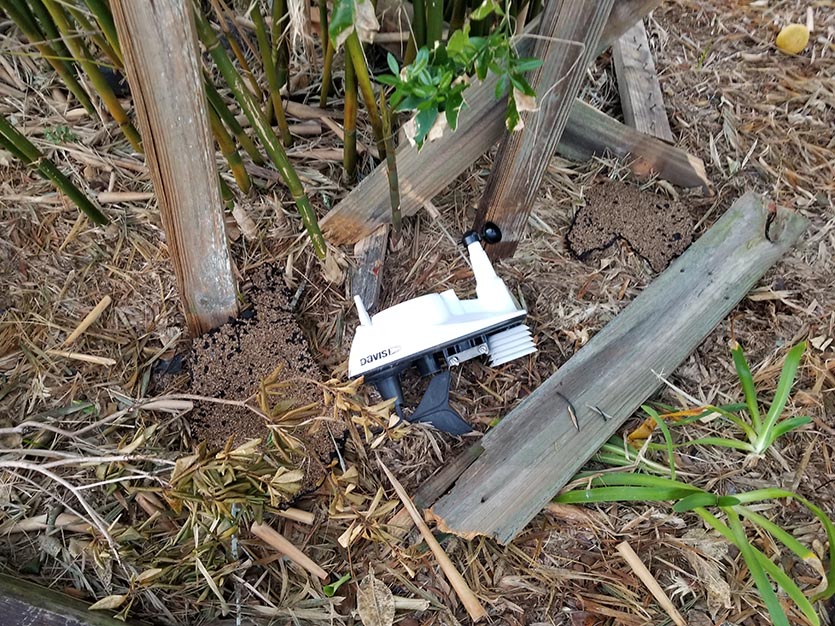| Above: A personal weather station anemometer was mounted on the peak of this roof, which tore away in the west eyewall of Hurricane Michael on October 10, 2018. Image credit: John Templeton. |
Hurricane Michael powered ashore along the Florida Panhandle near Mexico City Beach on October 10, 2018, as a catastrophic Category 4 hurricane with 155 mph winds and a central pressure of 919 mb. This made Michael the third strongest landfalling mainland U.S. hurricane on record by pressure and fourth strongest by wind. As typically occurs during a major hurricane landfall, wind measurements during passage of the eyewall were sparse, since the storm destroyed the measurement sites and/or knocked out their power. According to the National Hurricane Center, the official highest gusts observed during Michael’s passage were 130 mph at a University of Florida/Weatherflow observing site near Tyndall Air Force Base, and a gust of 129 mph at the Panama City Airport, before the instruments failed.
 |
| Figure 1. Analysis of Hurricane Michael’s wind field at 2 pm EDT October 10, 2018, one hour after the storm made landfall near Mexico City Beach, Florida. John Templeton’s PWS in Lynn Haven, Florida was in the west eyewall of Michael. Image credit: tropicaltidbits.com. |
There were a number of personal weather stations (PWSs) on the Weather Underground network in Michael’s landfall zone, and I heard from one owner in Lynn Haven, Florida, which received a battering from the western (weaker) eyewall of Michael. The PWS, owned by John Templeton, recorded a gust of 123 mph before the roof where it was mounted tore off and sent the anemometer spinning to the ground. When the 123-mph wind gust was recorded, though, the instrument was dangling upside down next to the roof, after a wind gust had ripped it down. In this position, distortion of the air flow by the side of the building likely impacted the measurement, calling into question the validity of the data taken. Ideally, a wind instrument should be mounted at a height of 10 meters (33 feet) above ground, far from any buildings. Had John’s instrument been mounted that way (and survived the flying debris!), it could well have measured a 123 mph wind gust at the peak of the storm, though, according to an email from hurricane wind expert Dr. Mark Powell of RMS.
 |
| Figure 2. John’s anemometer measured its peak wind gust of 123 mph while hanging upside down in this position. A few minutes later, a gust of wind tore the instrument away from the house and removed part of the roof. |
 |
| Figure 3. John found his anemometer three houses down, under a fence, four days after the storm. |
Here is John’s report on the event:
“I have been a member of wunderground for many years (airforceone), and have had weather stations in San Antonio, Terciera (Azores), Belleville, IL and Lynn Haven, FL, thanks to the Air Force shuffling me around the world. My personal weather station now is 'Parrothead1 in Mowat Highlands' on Davis' weather site and I was connected through wunderground prior to Hurricane Michael.
"When Hurricane Michael hit on Oct 10, my family rode it out in our home. We lost our garage door, kitchen ceiling, half our roof and attic over the garage, our car and many trees. Everyone stayed safe in the hallway, so we were grateful for that.
"I had 2 Davis Vantage Vue systems up for the storm, one 8 feet above the roof peak, and one 7 feet up on a pole in the yard. Both registered a low pressure of 942.3mb, and the roof mounted unit had a wind gust of 123 mph about 12:45 pm before it and the roof disappeared. I found the Vantage Vue three houses down under a fence four days after the storm.
"Our house is located 10 miles due north of Tyndall AFB, and about 22 miles NNW of Mexico Beach. We were in the western eyewall for about an hour, with most of our damage occurring as the storm pulled away and the winds had shifted more to the NW. We were without water for 7 days, and no power for 13 days. But luckily, we could flush toilets and bathe by manually filtering our pool water.
"I was able to repair my Vantage Vue using parts from both units, but unfortunately, we still are without internet, so my PWS remains offline. I am sure you have received a lot of weather data post storm from our area, but I figured the more data the better! I love reading Category 6 by the way, and live by it during hurricane season especially. Keep up the fabulous work. Thank you.”
Below is the video John took of his yard during passage of Hurricane Michael's eyewall.
Related post: A 199 mph Wind Gust in Irma: a Personal Weather Station Record



